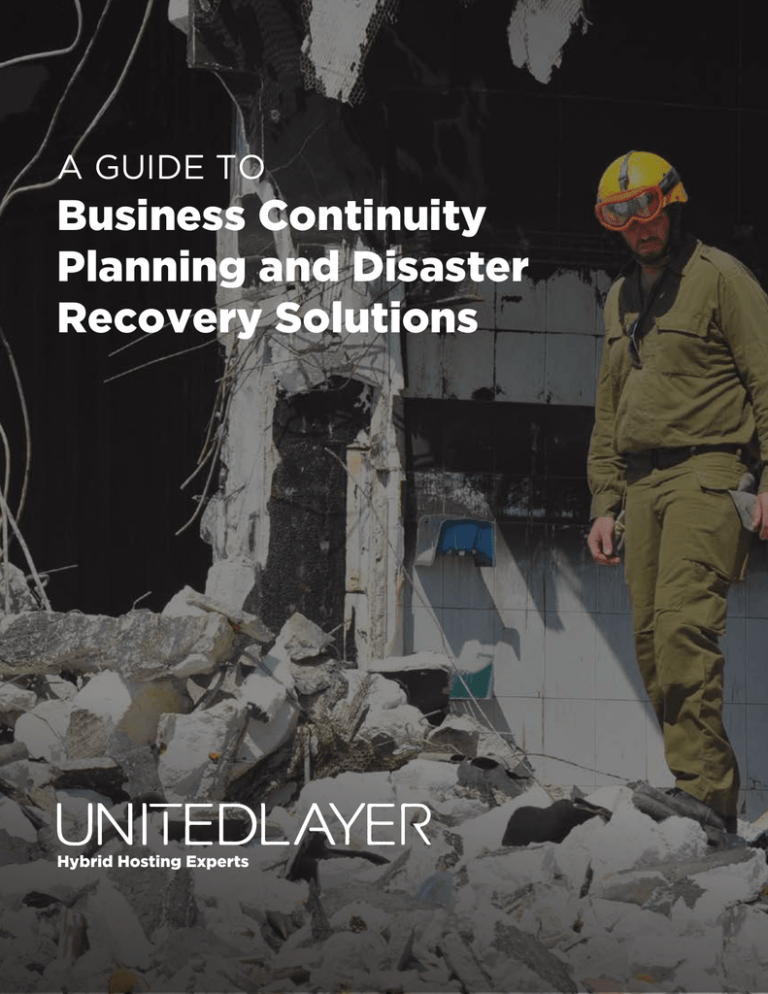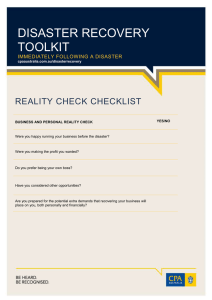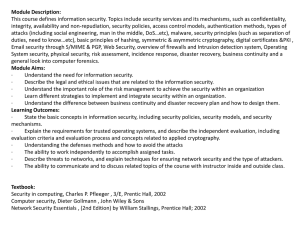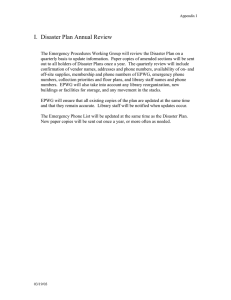
A GUIDE TO
Business Continuity
Planning and Disaster
Recovery Solutions
Hybrid Hosting Experts
Content
INTRODUCTION
3
TIPS FOR PROTECTING YOUR BUSINESS
5
HOW MANAGED SERVICES PROVIDERS CAN HELP
6
UNITEDLAYER DISASTER RECOVERY SOLUTIONS
7
ABOUT UNITEDLAYER
8
© 2014 UnitedLayer, LLC. All Rights Reserved | 2
Introduction
Business continuity and disaster recovery must be key parts
of a company’s overall planning process. Disaster events are
unpredictable; it is crucial to take a proactive approach in
the overall planning before it is too late.
Failure in any part of your business process can translate to
a loss of revenue; a situation no business wants to be in.
However, with a clear and well-thought-out business continuity and disaster recovery plan, your business can do
everything in its power to mitigate the risks and minimize
time to full recovery.
This paper gives you a simple outline of business continuity
planning. We’ll start with a brief description on the types of
events that can affect continuous operation of your business. We’ll then shift to IT considerations, offering solid
advice for protecting your organization’s critical technology
assets. Finally, we will discuss how managed solutions can
help streamline disaster recovery processes and minimize
the burden on internal IT resources.
BUSINESS CONTINUITY
PLANNING
HR, IT, POWER,
TELECOM, LOGISTICS
DISASTER RECOVERY
HIGH AVAILABILITY
ARCHIVAL
• Critical Systems
Identification
• Business Continuity
Drills
• Managed Services
• Availability, Backup,
Archival and Recovery
Services
© 2014 UnitedLayer, LLC. All Rights Reserved | 3
UnitedLayer operates more
than 40,000 sq ft of managed
space at 200 Paul Avenue in
San Francisco. We are a
24x7x365 operation that can
offer flexible and tailored
solutions to meet your IT
requirements.
Identify Potential Threats and Vulnerabilities
The first step in preparing your business for a disaster is identifying the potential
threats, such as:
Natural and localized disasters, such as earthquakes, floods, tornadoes, and fires
Failure of IT systems, such as the network, file servers, and software applications
Power outages, such as utility failures
Human threats, such as sabotage, virus attacks, terrorism, and other crimes
A business continuity plan takes into account such events and identifies issues that are
absolutely critical for maintaining the essential operations to run your business. The
plan should also take into account tangible and non-tangible costs your business may
need to cover during a failure event.
Business Continuity Planning
A business continuity plan encompasses not only IT, but also takes into account other
functions of the business, such as staff and facilities. A business continuity plan asks the
question: If there is an interruption to regular business processes, what is needed to
keep the business going? Look at everything that your business needs to stay
operational, IT and beyond.
During the planning process, it is also helpful to list business functions in order of
importance. Identify the functions that can result in the greatest financial loss to your
business if they were to fail. Which ones have the greatest impact on the service you
provide your customers? Ensure functions that have the greatest impact receive the
most attention.
Determine critical systems that require uptime and establish their Recovery
Time Objective (RTO) and Recovery Point Objectives (RPO).
-IDG Research Services, 2014
© 2014 UnitedLayer, LLC. All Rights Reserved | 4
UnitedLayer stays abreast of the latest technologies and
best practices. Count on UnitedLayer to be a strong partner
for your Business Continuity plans.
Tips For Protecting Your Business
There are many IT considerations when it comes to disaster recovery. The partnership between your
business continuity and disaster recovery processes will vary for every business. However, there are
some general tips applicable to most companies:
Organize a business continuity committee to be in charge of creating the disaster recovery plan, as
well as executing and evaluating as necessary.
– Ensure that other parts of the organization, including the IT team and any Managed Services
Providers, are involved.
– Determine critical systems that require very high uptime, and evaluate them with respect to how
they affect financial, PR, and other relevant criteria.
Establish a Recovery Time Objective (RTO) and Recovery Point Objective (RPO) for any IT systems
identified during this process.
Plan, schedule, and execute drills to identify and incorporate any ongoing process changes or
evolving business realities.
When it comes to disaster recovery, there are also some IT-related matters to consider:
Maintain adequate IT operations staff to handle the IT requirements during a disaster event.
To offset larger disasters, such as earthquakes or hurricanes, ensure that you are not depending on
one geographic location. Establish backups in at least one other geographic location.
To protect against inadvertent virus infections that might affect your primary and secondary
backups, or for any compliance or regulatory requirements, an archival solution such as a tape or
virtual tape backup will be necessary.
Maintain the ability to remotely manage your crucial data and functions.
© 2014 UnitedLayer, LLC. All Rights Reserved | 5
THERE'S A LOT TO THINK
ABOUT WHEN IT COMES TO
DISASTER RECOVERY
Just Do It Before Disaster
Strikes. UnitedLayer DR
Managed Services Can Help.
How A Managed Services
Provider Can Help
There are many IT considerations when it comes to disaster recovery.
Partnering with a Managed Services Provider is often advantageous
because you ensure that your data is well protected. You’re also likely to
save money by outsourcing to specialists who can recommend best
practices and have already made significant investments in reliable,
redundant, and monitored systems.
Here are some key ways that a Managed Services Provider can benefit
your business:
Modern Tier-3 comparable data centers used by reputable service
providers are designed and built with the backup infrastructure
required to allow them to operate on a standalone basis, even after
a disastrous event has occurred.
Typically, a Managed Services Provider is organized to operate in a
robust manner from locations that are geographically diverse. If
disaster strikes in one location, your outsourced Managed Services
team will have planned for such an event and will be able to retrieve
your data from another location.
A Managed Services team already understands the need for
maintaining critical systems and redundancy as they rely on their
own network for availability.
The best Managed Services Providers stay abreast of the latest
technologies and best practices, and they will use that expertise to
bolster the effectiveness of your own continuity plan.
© 2014 UnitedLayer, LLC. All Rights Reserved | 6
UNITEDLAYER DISASTER RECOVERY SOLUTIONS
One Partner, Endless Capabilities
As a premier Managed Services Provider, UnitedLayer can help ensure that your critical IT functions are
protected and safe.
At UnitedLayer, we understand your data is one of the most crucial assets of your business. Let us help
you protect your technology assets in the event of any disaster. Our managed services team will:
Participate in your business continuity planning process and help your business define parts of your
plan, such as Recovery Time Objectives (RTOs) and Recovery Point Objectives (RPOs).
Augment your IT staff during critical events by leveraging our IT staff, who are available 24x7x365.
Schedule periodic drills to ensure that your disaster plan is both effective and kept up-to-date with
your evolving business needs.
Leverage our Tier-3 data centers geographically dispersed in San Francisco, Los Angeles, Las Vegas,
Ashburn, Toronto and Vancouver. If your primary location goes down for any reason, a secondary
location will ensure that all data is backed up and available.
Allow you to take advantage of a robust IT infrastructure and network to continue to operate
despite any local failures in terms of localized power, natural disasters, or other unforeseen events
and threats.
All UnitedLayer systems are constantly monitored. Reports are issued on an ongoing basis to ensure
that any potential trouble spots are dealt with immediately.
We are committed to keeping your servers fully operational and always available with
around-the- clock service and support. Our team will alleviate the task-intensive and time
consuming installation process. In addition, our team can perform simple troubleshooting or
maintenance tasks 24x7x365.
Disaster Recovery Solutions from UnitedLayer Include:
Comprehensive audits of your business operations and data center
Redundancy across our Tier-3 data centers in multiple geographies: San Francisco, Los Angeles, Las
Vegas, Virginia, Toronto and Vancouver
Network architecture to meet your security, performance, and cost goals
Ability to replicate your expensive EMC and NetApp filers to cost-effective storage systems
Tape Backup, Rotation, Vaulting, and Recovery Services
Comprehensive recovery drills
© 2014 UnitedLayer, LLC. All Rights Reserved | 7
Key Takeaway
When it comes to disaster recovery planning for your business, ensure that
you understand the potential threats, and have a plan in place to deal with
them. Get your IT resources on board and don't go it alone. Enlist a
Managed Services Provider to increase the value of your team and plan.
UnitedLayer: One Partner. Endless Capabilities.
UnitedLayer is the Hybrid Hosting Expert, providing secure enterprise-grade Cloud, Disaster Recovery,
and Colocation solutions. UnitedLayer brings over 13 years of expertise, technology and knowledge in
enabling agility to enterprises, SMBs, government agencies and startsup through hybrid hosting
solutions - providing unified access, management and monitoring of multiple disparate infrastructures.
Our customers include The City and County of San Francisco, Wikipedia, Diamond Foods, The
Exploratorium, AT&T, Level3, and NEC. Headquartered at 200 Paul in San Francisco, UnitedLayer is
one of the most networked Internet points of presence in the world. We operate a dual-stacked,
high-performance, nationwide IPv4/IPv6 network backbone, and all of our services are backed by
high-touch fully-managed 24/7/365 support.
UnitedLayer currently operates six data centers in North America – in San Francisco, Los Angeles, Las
Vegas, Ashburn, Toronto and Vancouver, Canada – with numerous additional networking POPs.
© 2014 UnitedLayer, LLC. All Rights Reserved | 8
One Partner. Endless Capabilities.
San Francisco Colocation Data Center | 200 Paul Ave Suite 110 (HQ) San Francisco, CA 94124
Los Angeles Colocation Data Center | 530 West 6thStreet, Los Angeles, CA 90014
Las Vegas | Toronto | Virginia | Vancouver
Sales (866) 291-4914 | LA Sales (866) 486-7908 |
Main (866) 395-5346 | Toll Free (888) 853-7733 |
Support/NOC (415) 349-2102 (available 24x7) | Fax (415) 520-5700
sales@unitedlayer.com
© 2014 UnitedLayer, LLC. All Rights Reserved | 9





